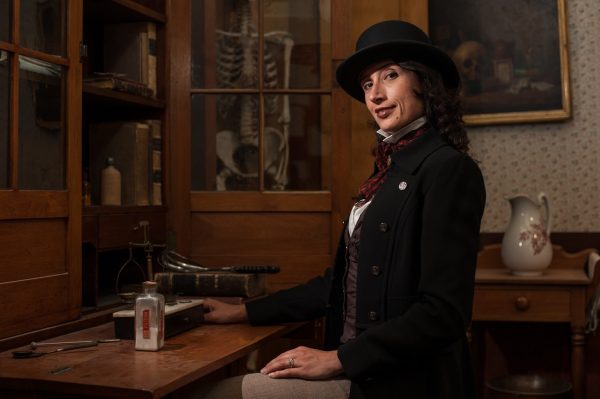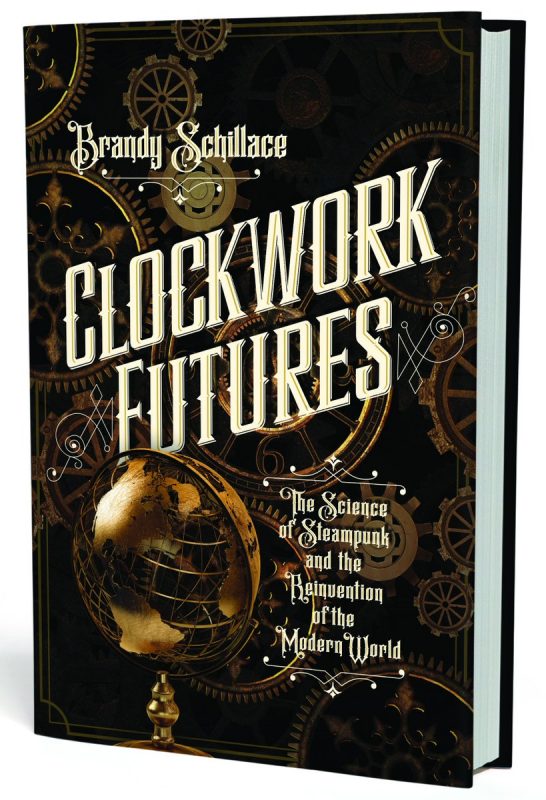Last month, I reviewed Brandy Schillace’s Clockwork Futures: The Science of Steampunk and the Reinvention of the Modern World. It presents the history of the natural sciences via steampunk. She was kind enough to answer a few follow up questions via email.
I enjoyed how the history of steampunk technology in Clockwork Futures comes across as a narrative. There is story of developments in a time and place, particularly nineteenth century England. It shows the impact and ramifications of the inventive minds of the time. Could you expound on how this narrative re-invented the modern world?
Good question—long answer. The human drive to innovate remains one of our most powerful, I think. Invention doesn’t just give us engines, it also generates art, culture, and all the bits and pieces that make our lives worth living. But the inventions that drove industry and the manufacture of power are uniquely responsible for our modern world—what it looks like, what it does, and how we respond to it. I was struck in my research by how much we accommodate to technology, rather than the reverse. Think of how you change your voice and inflection to communicate with Siri as an example. So it’s easy to see how technology, for better or worse, invents the modern world. It’s harder to see the re-invention.
I love Alice in Wonderland’s Red Queen. She tells Alice that a good memory works both ways. But of course in real life you can’t remember something before it happens. What you can do, what Steampunk fictions but also those who practice the Steampunk avant garde do, is to re-imagine history in order to shape and influence the future. I think fiction has always been better at future hunting than fact. It requires leaps outside the box to consider where our present technologies will lead us. Steampunk imagines a world where the combustion engine never reigns. That would mean a future not nearly so reliant on oil—but possibly much more reliant on coal. Let your imagination play with that. It tells us something about what might be possible and necessary in our own future, where fossil fuels lead to war and strife (and will one day run out, anyway). In our present moment, where innovation often outstrips our ability to imagine its consequence, the modern world and its future exist like quantum possibilities. Everything we do today reshapes tomorrow. We never invent; we always re-invent. Steampunk as an aesthetic lens makes this aspect primary.
Your previous book Death’s Summer Coat examined mortality. How did you transition from writing about life and death to writing a techno-history?
In many ways, both this present book and my last emerge from the same background; it’s less about one transitioning to the next than about the context in which I do most of my work. I am a medical humanities scholar and the senior research associate and public engagement fellow for a medical history museum. That makes me an adventurer at the intersections among humanities, medicine, science and tech. I am fascinated by the ways culture influences our understanding of human health… and what, for instance, art, literature, history, and social science can tell us about medical practice. Meanwhile, working in a museum means constant interaction with historical artefacts, with strange and unusual technologies, and with the practical history of public health. Each of these opens avenues for exploration—especially concerning the interface between mortal bodies and machines. For research on DSC, I was in the Paris catacombs. For research on CF, I went to Switzerland to see the clockwork writing boy. One chronicles the deaths of thousands in a high-volume city, the other our determination to mimic, understand, and even preserve life through technology. The two are always related.
What nineteenth century science did you want to include, but did not fit your narrative?
Oh, golly. For every one person I speak about there are ten more; most of them are really working on similar types of tech. I ended up cutting a lengthy section on air travel—hot air balloons, zeppelins, and more. I also had to curb my discussion of computing history (that’s a whole can of worms right there). I principally look at the age of manufactured power, but endless technologies march through the Victorian era.
If you were to expand Clockwork Futures’ timeline to include dieselpunk, what technological developments would you include?
I’m fascinated by early aircraft. I think I’d have spoken about those marvelous aviators—and in particular women who piloted aircraft in the interwar period. Spoiler alert: it’s not just Amelia Earhart traversing the deep clear blue. Australia’s Margaret Adams, first president of the Women’s Flying Club in 1938, or Lilian Bland, who built her own airplane and was first to fly in Ireland. Hmm. You have me thinking suddenly about a new book project… For me, though war loomed through the whole period, and though tech nearly always bends toward uses as defense or weaponry, it’s the technologies of exploration that I find most inspiring.
Clockwork Futures points out (by way of Paul Virilio) that new advancements can have unintended consequences. “The invention of the steam engine and locomotive was the invention of derailments.” What current technologies concern you?
I read Virilio’s work when I was a student. French philosophy isn’t for the faint of heart, but I simply could not put his work out of my head. Nearly everything we build ultimately allows for both the advancement of, or the destruction of humankind. The tech itself has no moral center. It cannot stop us from turning a plane into a bomb (and it’s noteworthy that Virilio warned of that possibility long before 9/11). I think we always fear nuclear power, or polluting engines. I think we’ve begun to fear AI (artificial intelligence). But it’s the ways we use and rely on technology that really concern me. If we are the moral center, acting on technology, then which technologies might today be robbing us of that center? How about the veritable onslaught of available information, presented without curators or librarians or filters or commentaries? Or the way CGI blends the real and not real? We have invented access to and proliferation of data faster than we’ve developed frameworks and structures to support them, or means of teaching ourselves how to use them. As I say in the book, that’s almost inventing the train crash ahead of the train.
Bonus question: What’s next?
*Leaping in secret joy that you asked* I am working on a hidden history of American forensics. I have privileged access to a unique and never before seen archive at the museum, the work of Cleveland toxicologist John G Spenzer. I will be taking a long look, not only at the dawn of forensic activity in the US, but also at what it meant to be a city of immigrants on the rise to national importance. The book will cover ten years of history (roughly 1910-1919), and the fascinating cases that allowed Spenzer (a savant) to compile his “blood books” for the teaching of forensics in a new, industrial, and multicultural world.
Pick up a copy of Clockwork Futures at your local bookstore!



There are no voices yet... Post-script us a message below, won't you?